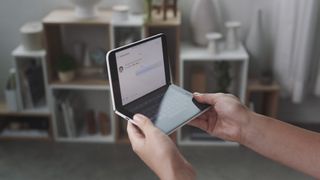
At an event at Microsoft’s flagship store in London, Panos Panay, the chief product officer for the Microsoft Devices group, admitted that the company is using Android in its upcoming Surface Duo phone because, quite simply, the “best OS for this product is Android”.
It’s a noteworthy admission, as Google’s Android mobile operating system is one of Microsoft’s biggest rivals. In the past, the company has tried – and failed – to take on Android with its own operating system for mobile devices: Windows Mobile.
While Windows 10 Mobile is no more, it must have been tempting for Microsoft to revive the OS for its upcoming dual-screen handset, so it’s commendable that it has gone for the much more popular Android operating system – while being so frank about its reasons.
On one hand, it seems like Microsoft has acknowledged just how hard it is to compete with Android – which is currently the most-used operating system on the planet – a title Microsoft’s own Windows OS used to have. The failure of Windows 10 Mobile, and the Windows phones that ran the software, was likely a humbling experience that the company is in no rush to repeat.
It also makes sense, as Panay explained: “we wanted to meet customers where they were… and they were with Android.” If potential customers are already using Android, is it worth building a rival solution from scratch to try and win them over? Microsoft obviously no longer thinks so.
As for the dual-screen laptop Surface Neo, Panay had an answer we’d expect from Microsoft. “The best OS for this product is clearly Windows.”
Upgradable future
Panay also revealed that “our commitment is that all our products will be serviceable over time”. This is fantastic news – one of the highlights (in our view) of the Surface Pro X and Surface Laptop 3 reveals at the beginning of October was the announcement that the devices would be more easily upgraded and fixed compared to previous Surface devices – for example having a removable SSD that users can quickly replace.
In the past, Microsoft has been criticized for creating devices that are almost impossible to open up and fix without sending it off – which can prove to be a costly and inconvenient experience. By allowing its customers (or trusted third parties) to open up and replace various components, Microsoft is proving that it’s actually listening to (and learning from) its critics.
Panay’s comment that Microsoft will be making all of its products serviceable at some point is great to hear. Hopefully soon we’ll see Surface Pro tablets and Surface Studio all-in-ones that can be easily fixed and upgraded.
Making the new Surface devices easier to upgrade and fix was, Panay revealed, one of the most requested features from Microsoft’s customers. “This is my favorite example of customer feedback,” he said.
But it wasn’t just about making it easier for customers. After all, as Panay said, “At the end of the day, you don’t buy a product because you can take it apart.”
The increased serviceability will also help Microsoft become a greener company. “For sustainability, it helps us reduce our footprint with carbon emissions,” Panay added.
That means Microsoft can service those devices quicker. “We can change out a keyboard, we can change out a screen, we can change out an SSD quickly – and do it without shipping products around the world and trying to find a place to repair them. It is, in a sense, the biggest customer feedback we’ve had.”
[“source=techradar”]
